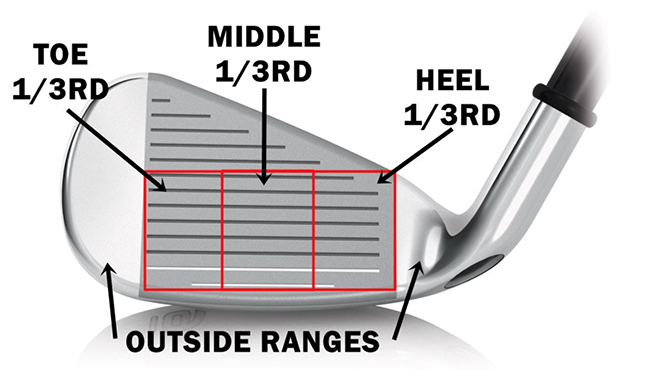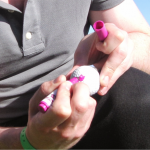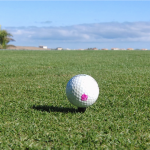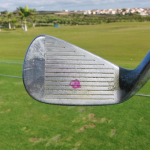Instruction
A winter golf drill to improve your ball striking

My most recent articles on GolfWRX have highlighted the importance of golfers to striking the sweet spot more often. The next logical step is to describe some ways golfers can improve that ability, which is the focus of this article.
Now that winter is well and truly in motion, golfers are left to spend their dark nights at the floodlit or indoor range. Others are reduced to backyard/garage practice — perhaps into a net, if a golfer is lucky enough to own one. The good news about winter is that it is the perfect time for golfers to work on their ball striking, and I will share an exercise that has been proven to work very well, and add a twist that creates even better results.
The Drill
If you’ve read my last few of articles, you know the marker pen drill well. Here is a quick re-cap of it.
- Mark the ball with a dry-erase marker pen.
- Place the ball as shown.
- Check where you hit on the face.
The Twist
This time we are going to do something a little strange, but I will explain some results of a study I conducted with golfers, which justifies my reasoning. Instead of marking the golf ball and trying to hit the middle of the face over and over, we are going to try and hit three different sections of the face.
- Hit 30 golf balls.
- Alternate between trying to hit the middle, the heel and the toe section (10 balls each section).
- Keep track of your results.
- Whichever section you had the lowest score with, do the next 10 golf balls focusing on only hitting this section.
- Repeat.
The Science
Golfers who follow me know I approach things from a motor learning science perspective. Practicing something you wouldn’t normally want to do (such as hitting off-center shots), but which is closely related to the skill you want to improve (hitting the ball on the sweet spot) is known in scientific circles as “differential practice.”
A few years ago, before I had even heard of this term, I conducted a study with three groups of golfers.
- Group 1 tried to only hit the sweet spot.
- Group 2 tried only to hit either toe or heel sections.
- Group 3 did a mixture of both.
What most of you would guess is that Group 3 ended the five days with the most improvement (as defined by their ability to hit the middle of the face). However, what shocks most people (and shocked me at the time) was that Group 2 outperformed the “sweet-spot only” group. That’s right; trying to only hit the sweet spot improved their ability to hit the sweet spot less than those who were intentionally trying to miss it.
What a counterintuitive result! It looks as though the old mantra of “perfect practice makes perfect” needs to be thrown out of the window.
There are several theories for why this works — including improved perception-action coupling, increased external focus of attention (as opposed to focusing on body movements), improvements in the ability to adapt degrees of freedom, etc. However, for the average golfer, it doesn’t matter exactly how it works — just that it works!
End notes
The next time you are stuck indoors as it is raining (or snowing) cats and dogs, get into your garage and peg a few up. Spend an hour or so working on this drill and you won’t be sorry when spring time rolls around. I have even modified the drill slightly for those without a net in their garage. As long as you have a room big enough to swing a golf club, why not?
Here’s the modified two-step drill.
Step 1
Step 2
Note: Adam describes differential practice drills, as well as many other forms of practice you can use to speed up your golf improvement, in his amazon bestselling book “The Practice Manual – The Ultimate Guide for Golfers.” But it on Amazon.
- LIKE150
- LEGIT34
- WOW29
- LOL7
- IDHT5
- FLOP5
- OB6
- SHANK20
Instruction
Clement: Laid-off or perfect fade? Across-the-line or perfect draw?

Some call the image on the left laid off, but if you are hitting a fade, this could be a perfect backswing for it! Same for across the line for a draw! Stop racking your brain with perceived mistakes and simply match backswing to shot shape!
- LIKE0
- LEGIT0
- WOW0
- LOL0
- IDHT0
- FLOP0
- OB0
- SHANK1
Instruction
The Wedge Guy: The easiest-to-learn golf basic

My golf learning began with this simple fact – if you don’t have a fundamentally sound hold on the golf club, it is practically impossible for your body to execute a fundamentally sound golf swing. I’m still a big believer that the golf swing is much easier to execute if you begin with the proper hold on the club.
As you might imagine, I come into contact with hundreds of golfers of all skill levels. And it is very rare to see a good player with a bad hold on the golf club. There are some exceptions, for sure, but they are very few and very far between, and they typically have beat so many balls with their poor grip that they’ve found a way to work around it.
The reality of biophysics is that the body moves only in certain ways – and the particulars of the way you hold the golf club can totally prevent a sound swing motion that allows the club to release properly through the impact zone. The wonderful thing is that anyone can learn how to put a fundamentally sound hold on the golf club, and you can practice it anywhere your hands are not otherwise engaged, like watching TV or just sitting and relaxing.
Whether you prefer an overlap, interlock or full-finger (not baseball!) grip on the club, the same fundamentals apply. Here are the major grip faults I see most often, in the order of the frequency:
Mis-aligned hands
By this I mean that the palms of the two hands are not parallel to each other. Too many golfers have a weak left hand and strong right, or vice versa. The easiest way to learn how to hold the club with your palms aligned properly is to grip a plain wooden ruler or yardstick. It forces the hands to align properly and shows you how that feels. If you grip and re-grip a yardstick several times, then grip a club, you’ll see that the learning curve is almost immediate.
The position of the grip in the upper/left hand
I also observe many golfers who have the butt of the grip too far into the heel pad of the upper hand (the left hand for right-handed players). It’s amazing how much easier it is to release the club through the ball if even 1/4-1/2″ of the butt is beyond the left heel pad. Try this yourself to see what I mean. Swing the club freely with just your left hand and notice the difference in its release from when you hold it at the end of the grip, versus gripping down even a half inch.
To help you really understand how this works, go to the range and hit shots with your five-iron gripped down a full inch to make the club the same length as your seven-iron. You will probably see an amazing shot shape difference, and likely not see as much distance loss as you would expect.
Too much lower (right) hand on the club
It seems like almost all golfers of 8-10 handicap or higher have the club too far into the palm of the lower hand, because that feels “good” if you are trying to control the path of the clubhead to the ball. But the golf swing is not an effort to hit at the ball – it is a swing of the club. The proper hold on the club has the grip underneath the pad at the base of the fingers. This will likely feel “weak” to you — like you cannot control the club like that. EXACTLY. You should not be trying to control the club with your lower/master hand.
Gripping too tightly
Nearly all golfers hold the club too tightly, which tenses up the forearms and prevents a proper release of the club through impact. In order for the club to move back and through properly, you must feel that the club is controlled by the last three fingers of the upper hand, and the middle two fingers of the lower hand. If you engage your thumbs and forefingers in “holding” the club, the result will almost always be a grip that is too tight. Try this for yourself. Hold the club in your upper hand only, and squeeze firmly with just the last three fingers, with the forefinger and thumb off the club entirely. You have good control, but your forearms are not tense. Then begin to squeeze down with your thumb and forefinger and observe the tensing of the entire forearm. This is the way we are made, so the key to preventing tenseness in the arms is to hold the club very lightly with the “pinchers” — the thumbs and forefingers.
So, those are what I believe are the four fundamentals of a good grip. Anyone can learn them in their home or office very quickly. There is no easier way to improve your ball striking consistency and add distance than giving more attention to the way you hold the golf club.
More from the Wedge Guy
- The Wedge Guy: Golf mastery begins with your wedge game
- The Wedge Guy: Why golf is 20 times harder than brain surgery
- The Wedge Guy: Musings on the golf ball rollback
- LIKE88
- LEGIT14
- WOW6
- LOL1
- IDHT0
- FLOP4
- OB1
- SHANK8
Instruction
Clement: Stop ripping off your swing with this drill!

Not the dreaded headcover under the armpit drill! As if your body is defective and can’t function by itself! Have you seen how incredible the human machine is with all the incredible feats of agility all kinds of athletes are accomplishing? You think your body is so defective (the good Lord is laughing his head off at you) that it needs a headcover tucked under the armpit so you can swing like T-Rex?
- LIKE0
- LEGIT3
- WOW2
- LOL0
- IDHT0
- FLOP0
- OB0
- SHANK2
-

 19th Hole1 week ago
19th Hole1 week agoJustin Thomas on the equipment choice of Scottie Scheffler that he thinks is ‘weird’
-

 19th Hole1 week ago
19th Hole1 week ago‘Absolutely crazy’ – Major champ lays into Patrick Cantlay over his decision on final hole of RBC Heritage
-

 19th Hole3 weeks ago
19th Hole3 weeks agoTwo star names reportedly blanked Jon Rahm all week at the Masters
-

 19th Hole2 weeks ago
19th Hole2 weeks agoReport: LIV Golf identifies latest star name they hope to sign to breakaway tour
-

 19th Hole2 weeks ago
19th Hole2 weeks agoNeal Shipley presser ends in awkward fashion after reporter claims Tiger handed him note on 8th fairway
-

 19th Hole2 weeks ago
19th Hole2 weeks agoBrandel Chamblee has ‘no doubt’ who started the McIlroy/LIV rumor and why
-

 Equipment3 weeks ago
Equipment3 weeks agoWhat we know about Bryson DeChambeau’s 3D-printed Avoda irons
-

 19th Hole6 days ago
19th Hole6 days agoLET pro gives detailed financial breakdown of first week on tour…and the net result may shock you























BoomBoom
Feb 29, 2016 at 2:40 pm
This is is an invaluable tip imo.
I recently the author’s book, which contains this drill recommendation (and many others). This drill specifically has been super helpful in improving my strikes. I’m currently working through fixing a tendency to hit short irons near the heel which I discovered as a result of grabbing a dry erase marker and pounding some balls into my net in the garage. It would’ve taken me ages to just feel/figure out on my own that almost all my strikes were too far to the inside.
I only wish there was a way that was as precise and completely cost free as this method to get post-shot feedback on path and face angles.
Chris
Jan 2, 2016 at 8:58 pm
Do you have am idea of how to correct a slight over the top swing? I will try it and leave my feed back. Thank you
James
Dec 15, 2015 at 1:10 pm
I definitely going to give this a try over the next few weeks. It reminds me of a drill to fix the shanks. Most people think they need to just move the ball out to the toe and make the same swing. But that actually makes it worse. What works is to do the opposite and line the ball up on the hosel. You look down you realize you have to adjust something in your swing else you will completely whiff the ball. It’s almost magical, yet very counter intuitive for most people to grasp.
Adam Young
Dec 16, 2015 at 4:02 am
Good point James. I have also carried out a study looking at that thing (or very similar). You can read the study here (it’s actually where I got this picture from)
http://www.adamyounggolf.com/blind-golfers-the-study/
Mbwa Kali Sana
Dec 12, 2015 at 3:26 pm
It’s completely ridiculous to try to ” hit the ball” at a given place OF the clubface And a loss OF Time .Better work on the FUNDAMENTALS OF YOUR golf swing And on YOUR physical weaknesses .
The club goes too fast to have any Contrôl OF where the clubface Will contact the ball . When I swing ,I never think about the ball :all I know is it ‘s there ,And my club picks it up on it’s way
Adam Young
Dec 13, 2015 at 10:48 am
Mbwa – if you currently don’t posses the skill to do this (which it sounds as though this is the case), try making the drill easier by doing it with chipping swings or even putting first. It is entirely possible to do this and master the skill of being able to hit where you desire on the face. With my elite players, we focus on different grooves, or even splitting the face into 10 parts, having a height and a toe/heel element to it.
Adam Young
Dec 13, 2015 at 10:51 am
Also Mbwa, this is a fundamental. In fact, being able to hit where you want on the face is even more of a fundamental than grip stance and posture.
Brad young
Dec 21, 2015 at 10:42 am
This helps engage the right side of your brain – the part that will help with “feel”, which will greatly help when you get out on the course. When you are out on the course, if you are thinking bout technical aspects of your swing, you will not play well. It’s all about feel out there, and hitting the correct spot of the ball with the correct spot of the club.
“The club goes way too fast to have control of where the club face will contact the ball”. This is so not right. If you go to the range, can you not purposely hit the ball with the toe or heel of the club? If not, maybe this is a “physical weakness” you should work on. It may really help you when you are out on the course.
terry
Dec 10, 2015 at 5:47 pm
I’m going to try this practice.
Here is how I practice at home in my man cave. Get a length foam pipe cover (about 3′) at a plumbing supply place. Cut a piece off about the height of a golf ball. Put a piece of electrical tape on the clubface it’s full width. On the bottom of the “foam ball” (across from the joint) with lip balm or lip stick draw a line maybe 1/2″ tall. Swing. The lip balm leaves a mark on the electrical tape showing exactly where on the clubface the ball was struck. You have to refresh the mark on the ball every 3rd swing or so but only takes a second. The foam ball pops up in the air and does no damage. It shows where you are making contact with the ball. But doesn’t tell anything about distance or trajectory of course. I can do a full pitching wedge swing in my mancave…. do this all year round. Is excellent for those who no option other than swinging a club inside their living quarters.
ParHunter
Dec 10, 2015 at 12:00 pm
Could this differential practice be applied to the low point as well? So trying to intentionally hit a shot fat, then trying to hit the ball into the ground, then catching it clean?
Problem is the feedback I guess. Does anyone know a mat that shows where the clubfaces makes impact with the ground?
Adam Young
Dec 10, 2015 at 6:07 pm
There is a mat coming out soon – within the next year or so.
ParHunter
Dec 11, 2015 at 6:19 am
Great, I was looking for something like that. Should be easy to do. There are fabrics that look different depending to which side you brush them.
Adam Young
Dec 11, 2015 at 12:24 pm
Ive experimented with a lot of things. Luckily, we have a fairway bunker at our facility which offers great feedback for ground strike.
jason
Dec 10, 2015 at 9:52 am
I do not have a net but would like to try this drill over the winter. What are the details on the modified two step drill? Are you just marking a plastic tee and clipping it? Are you setting up the tee height the same distance for an iron or where the equator of the ball would be?
Adam Young
Dec 10, 2015 at 11:17 am
Yes, just the tee – it’s for those without a net or whiffle ball. The marks will typically be on the bottom groove, although I get my players to experiment with hitting different heights on the face with different tee heights. This works on your ability to control the swing arc height and low point position simultaneously (a requirement for great striking ability)
Jamie
Dec 9, 2015 at 11:28 pm
Do you address it at the center of club face, then try to hit it off toe/heel? Or, do you address it on the toe/heel wherever you’re trying to hit it?
Adam Young
Dec 10, 2015 at 7:11 am
Start with addressing it where you want to hit it. However, I have variations of the drill which involve much more difficulty, which I progress players to as their rate of success increases. For my elite players, I often get them to hit different shapes while addressing the ball in various manners. You will rarely see this type of practice conducted by most, but my quantified research on the tee is showing some promising results over ‘standard’ methods of practice.
Taylor
Dec 9, 2015 at 6:58 pm
Such a hassale to keep marking golf balls…just put painters tape on your club face and you have impact tape. Masking tape words too, but I can see it better with painters tape. Replace tape after a few hits.
Adam Young
Dec 9, 2015 at 8:10 pm
Dr Scholls is also a good option – just spray the face and off you go (although it can be more expensive).
I prefer marker pen in my teaching, as it can be a easier to quantify and see multiple hits.
TR1PTIK
Dec 9, 2015 at 11:33 pm
Another benefit of the marker is that it provides a more accurate picture of the exact point of impact though I do prefer Dr. Scholls. You can also purchase the Great Value brand at Walmart, but it’s not that much cheaper and if I did develop a case of athlete’s foot I’d rather of a name brand product to use. lol.
Tom
Dec 10, 2015 at 2:06 pm
I was spraying Dr, Scholls om my iron face on the range yesterday and the guy in the next stall had a perplexed look. His buddy came by and ask him what I was doing and he replied ” it keeps him (me) fom spraying balls all over the range.
Adam Young
Dec 9, 2015 at 6:46 pm
Hi guys – it would be important to note that the ‘differential practice’ group had worse performance initially, but their ability to strike the sweet spot improved after 5 days. The link to the original study is here
http://www.adamyounggolf.com/the-study-differential-versus/
BAL
Dec 9, 2015 at 4:08 pm
How should one try to hit off-center to get the most out of this drill? Is it in distance from ball in setup or is it an adjustment in the swing by feel?
TR1PTIK
Dec 9, 2015 at 4:44 pm
When I tried this a while back I played with stance and swing, but there are so many variables you can play with. Ultimately, it’s going to be whatever produces the most consistent results.
TR1PTIK
Dec 9, 2015 at 3:41 pm
I toyed with this a while back when working on my driver and had good results. My miss with driver stems from striking the ball low and off the heel of the club so I intentionally tried to impact the ball high and toward the toe. Made a tremendous difference in my ball striking with that club. It’s cool to see an article months later that confirms I was on the right track.
Adam Young
Dec 9, 2015 at 8:12 pm
That’s right – often times, trying the opposite pattern to our fault can help to balance this out. Over time, you become less conscious of ‘trying’ to correct it, and it becomes automatic. This can be lumped under the term ‘perceptual adaptation’.
golfraven
Dec 9, 2015 at 3:10 pm
I really like the idea of the marker on small plastic tee. Have dozens of those and will certainly try out.
Adam Young
Dec 9, 2015 at 8:13 pm
You can also pop it on a whiffle/airflow ball. I like the tees – you can really refine which groove you hit if you are a better player
Steven
Dec 9, 2015 at 2:44 pm
Great article. I am glad to see that someone is paying attention to this line of research. It has some pretty interesting results.
Jay
Dec 9, 2015 at 3:26 pm
I believe Karate Kid pioneered this line of research/training
Adam Young
Dec 9, 2015 at 8:14 pm
Yes, differential practice is not commonly known. It blows away the ‘perfect practice makes perfect’ mantra. I have evidence of its efficacy in other studies I have done also.